 Heath Fritillary Mellicta athalia, male, Blean Woods, Kent – Adrian Hoskins
Heath Fritillary Mellicta athalia, male, Blean Woods, Kent – Adrian Hoskins
Introduction
The genus Mellicta contains between 12-16 species depending on whether certain taxa are treated as subspecies or full species. The genus is centred on temperate Asia but there are 9 species whose range includes or lies entirely within Europe i.e. asteria, athalia, aurelia, britomartis, deione, varia, nevadensis, caucasogenita and parthenoides.
All Mellicta species have orange-brown uppersides overlaid with a linear network of blackish spots and lines. The undersides are all very similar, being pale yellow with a central band of pale spots, pale submarginal lunules and other pale spots set within an orange basal area.
In mainland Europe the Heath Fritillary is a common and widespread species, absent only from the southern Iberian peninsula and the Mediterranean islands. It’s range also extends eastward across temperate Asia to Japan.
In Britain it is highly localised and by the late 1970s had become so scarce that it was in danger of extinction. Fortunately changes in forest management strategies have since enabled its populations to recover at its traditional sites in Kent and on Exmoor, and it has now been introduced to sites in Essex where small colonies flourish in woods near Southend.
The adult cannot be confused with any other British species, except perhaps the Glanville Fritillary, which only occurs on the Isle of Wight, an area from which the Heath Fritillary is absent.
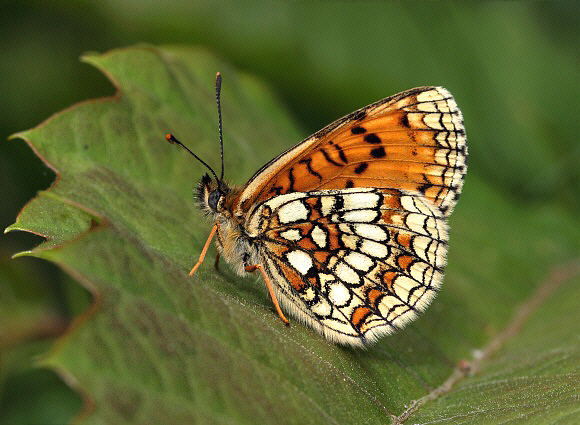 Heath Fritillary Mellicta athalia, Belfairs Wood, Essex – Adrian Hoskins
Heath Fritillary Mellicta athalia, Belfairs Wood, Essex – Adrian Hoskins
Habitats
In Europe the butterfly can be found in a wide range of habitats including woodland, hay meadows, sub-alpine pastures, scrubby grassland and roadside verges.
In Britain it is at the edge of it’s range, and is restricted to a very limited range of habitats. It was formerly widespread in southern counties of England, and was once abundant in Killarney, Ireland, but habitat loss and other factors including climate and parasitism, led to it’s decline. Now it is found in just a handful of sites in Kent, Devon, Cornwall and Essex.
In Kent and Essex the species is confined to few small woodlands which are managed as hornbeam or sweet chestnut coppice, with a fairly open canopy of oaks. The butterflies can be found in small clearings or glades where the larval foodplant cow wheat grows profusely. Populations tend to peak about 3 years after coppicing. After this the habitat becomes shaded out and the butterflies quickly disappear. The adults are capable of dispersing over short distances, so if freshly coppiced areas become available nearby they are quickly colonised. It is vital however that the forest is coppiced on a regular cycle so that suitable areas are always available for colonisation, and that there are sufficient sunny tracks or rides in the wood which the butterflies can use as dispersal corridors.
An unpublished survey of north Kent in 2007 by Hoskins found that Heath Fritillaries were present in almost all of the woodlands north and west of Canterbury. 13 separate colonies were located, each comprising between 10-60 adults per day during peak flight season.
The sites on Exmoor in Devon are very different in nature – sheltered hillsides and lightly wooded valley bottoms where the foodplant grows amidst bracken or heather.
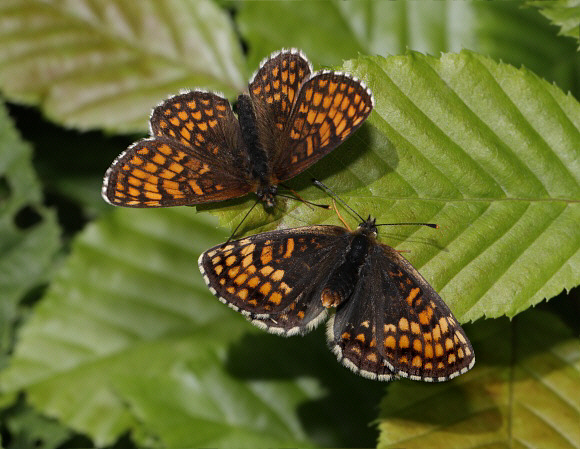 Mellicta athalia female raising abdomen to male, as a rejection signal, Essex – Adrian Hoskins
Mellicta athalia female raising abdomen to male, as a rejection signal, Essex – Adrian Hoskins
Lifecycle
The Heath Fritillary is single brooded in Britain and northern Europe, but is double brooded in Spain, Portugal, southern France and Italy. In Britain the adults emerge from mid-late May to early June in Devon, and in mid-late June in Kent and Essex.
The eggs are yellow at first, but later turn greyish, and hatch after about 10 days. They are laid in large untidy batches on the underside of bramble, foxglove or other large leaves low on the ground. Sometimes they lay under dead fallen leaves of sweet chestnut or oak, in the vicinity of the larval foodplants, but rarely on the foodplants themselves.
The young larvae spin thin silk webs over the leaves of the foodplants, and bask on these in groups of about a dozen or so. They enter hibernation in September when still fairly small, and spend the winter clustered together on dead leaves on the ground. In March they awaken and resume feeding on cow wheat Melampyrum pratense, sometimes supplemented with germander speedwell Veronica chamaedrys or foxglove Digitalis purpurea. In Cornwall, ribwort plantain Plantago lanceolata is used instead. In early May the larvae give up their communal behaviour and live solitarily, feeding and basking openly on the upper surface of leaves of the foodplants. The fully grown larva is black with rows of short white and yellow spikes along its back and sides.
The chrysalis, which is formed amongst dead leaves and twigs on the ground, is white, decorated with numerous small black and yellow spots. The pupal stage is short, usually only about 8-12 days.
 Heath Fritillary Mellicta athalia, Hockley Wood, Essex – Adrian Hoskins
Heath Fritillary Mellicta athalia, Hockley Wood, Essex – Adrian Hoskins
Adult behaviour
Adults are typically found flying in groups of between 10-100, in isolated sunny pockets within their habitats. Sometimes, if breeding sites are well managed and climatic conditions are suitable, much larger populations can arise, comprising of several hundred individuals.
Males patrol lazily about the habitats searching for freshly emerged females. During courtship the male flutters excitedly around the stationary female. If she is receptive she holds her wings erect and allows the male to crawl alongside her. Prior to copulation the male rubs his antennae against the hindwings of the female, and then while alongside her he curves his abdomen around to make sexual contact. Once copulated he turns to face away from the female. While copulated the female will usually open her wings to bask, but the male keeps his wings erect over his back. If disturbed a copulated pair will take flight, with the female carrying the male. I have found mated pairs on many occasions, either sitting in exposed positions on bramble flowers or at rest under bramble leaves. The pheromones released by the females are very potent, and often simultaneously attract many males which cluster around, trying to copulate with the female. Gravid females are also continually pestered by males, which are rarely deterred by the female’s “raised abdomen” rejection signal.
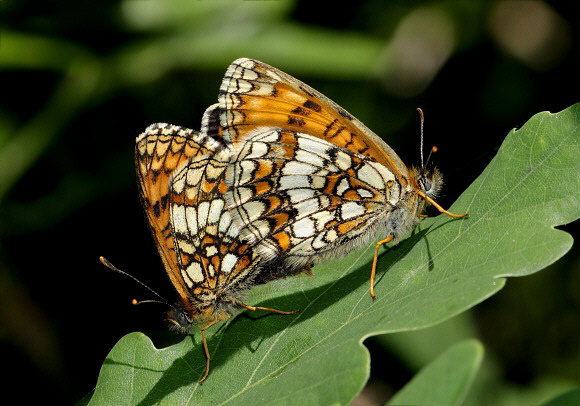
Heath Fritillary Mellicta athalia, Belfairs Wood, Essex – Adrian Hoskins
The butterflies nectar at flowers including bugle, heather, lesser stitchwort and buttercups, but show a strong preference for hawkbit and bramble blossom. Females often feed for several minutes at a particular blossom, but males tend to flit more frequently from flower to flower. On many occasions I have found adults in the grip of crab spiders Misumena vatia, which lie in wait on bramble flowers, ready to ambush any butterfly that settles to feed.
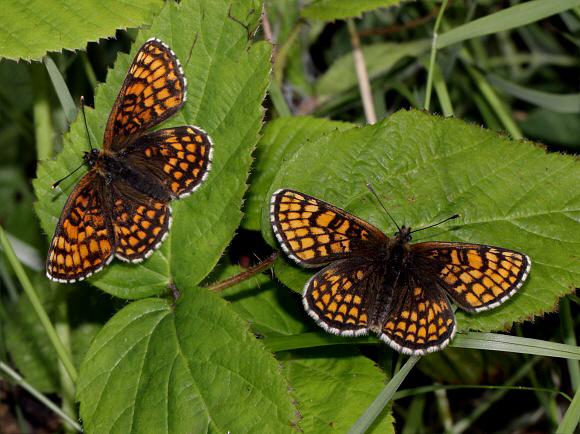
Heath Fritillary Mellicta athalia, Belfairs Wood, Essex – Adrian Hoskins
Small groups of adults can be found at dusk on dry days, roosting on sedges, rushes, or on the terminal foliage of low-growing herbs. I have also found them roosting on grass-heads, red clover, bracken fronds, or amongst the foliage of coppiced sweet chestnut.
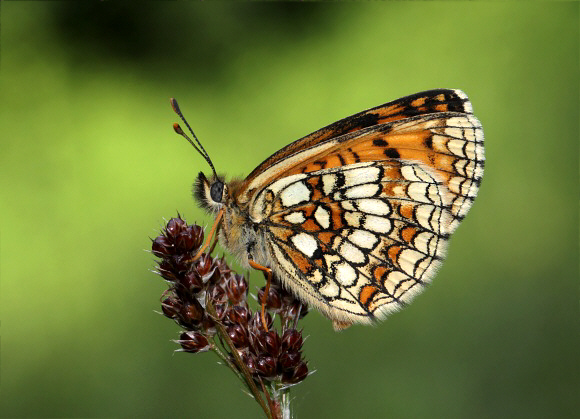
Heath Fritillary Mellicta athalia, Belfairs Wood, Essex – Adrian Hoskins
